
Stephanocystis geminata
Northern Bladder Chain
Two intertidal zone Whispering interactions took place – one on June 26th at Fishboat Bay and the second two weeks later at French Beach on July 11th. Conditions are as noted below:
26 June 2025
Fishboat Bay, Juan de Fuca Strait, B.C., Canada.
Tide: -0.7 foot low at 09:29 PDT (measured at Sheringham Point Tidal Station)
Weather: Overcast, wind variable 5 – 10 km/hour, sea rippled, no swell, humidity 88%, 13 ˚C.
Moon: Waxing Crescent (2.5%, 1 day); Next Phase, First Quarter, 2 July 2025 at 12:30 pm PDT; Previous Phase, New Moon, 25 June 2025 at 3:31 am PDT.
and:
11 July 2025
French Beach, Juan de Fuca Strait, B.C., Canada
Tide: 0.5 foot low at 9:20am PDT (measured at Sheringham Point Tidal Station)
Weather: Mainly clear, wind WSW 0 – 10 km/hour, sea rippled, low westerly swell, humidity 85%, 14 ˚C.
Moon: Waning Gibbous (99.1%, 16 days); Next Phase, Third Quarter, 17 July 2025 at 5:37pm PDT: Previous Phase, Full Moon, 10 July 2025 at 1:36pm.
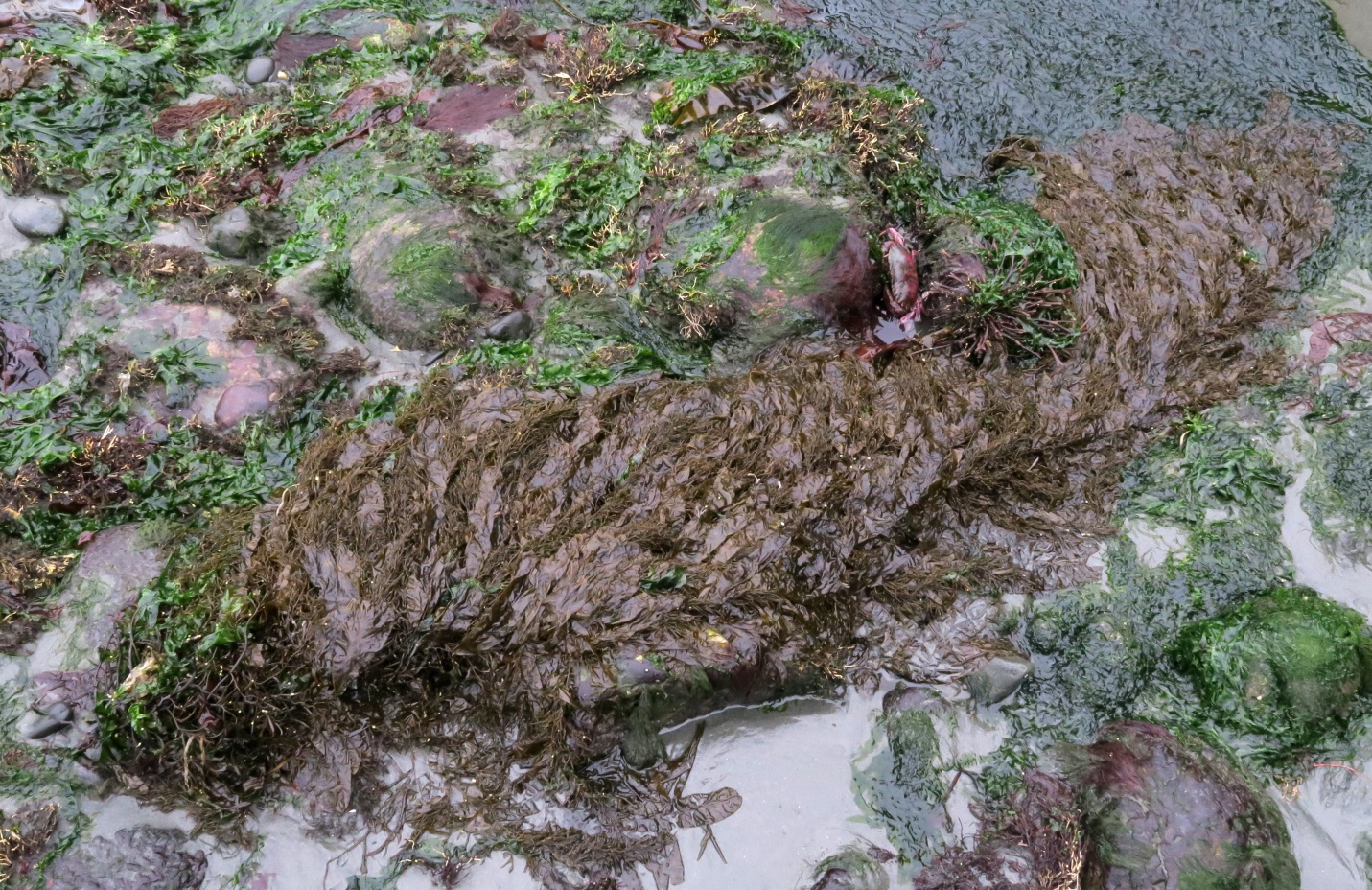
Figure 1: Depicted here is Stephanocystis geminata; its holdfast is on a large sand buried cobble (lower left corner) and the perennial base of the seaweed is a darker brown color. The new annual growth extends with the production of many branchlets and small floats and is a lighter brown color. Confusing the understanding of this seaweed’s structure is the presence of hundreds of light brown, deflated balloon shaped seaweeds called Sea Chip; these epiphytes grow only on S. geminata as is seen here. Fishboat Bay, Juan de Fuca Strait, B.C., Canada. June 26, 2025. Photo ID 27785 ©Seaweedwhisperings.com
Person 1:
Weighed down by Sea Chip.
Cheerily accepts the load.
Grows long.
Has a leisurely, carefree aspect to it.
Particular in where it wants to grow.
Long flowing robe or a long, heavy version of a “feather boa”, scarf or shawl --- like a long flowing shawl or stole. That was my impression of the Stephanocystis geminata and Sea Chip groupings that were exposed at low tide this morning.
In the water it had that sense of going on into the ether. It was tight near the holdfast then kind of floated expansively.
Very busy accomplishing its goals. Not easily distracted. It’s inward when busy with its goals.
But it will make time to listen to others and incorporate their ‘good’ ideas into their life or way of being.
Pleased to share, pleased to accept.
Prefers the inertia of the perennial part, but grows huge for a while to create energy for its ‘down time / inertia’.
It’s only big for a while; it breaks in the first big storm, probably one in late summer not December. It wants to grow, but retreats quickly back to the inert part.
That inert ‘down time’ is where they can learn from this year and get ready for next year.
Gentle slow swishing movement; no hurry, the movement is not belabored.
Its movement reminded me of the undulations of a fish slowly moving upstream, or maybe more like a basking shark (Cetorhinus maximus) which is very lethargic. Plankton-eating basking sharks are very big and very slow moving; they have the habit of feeding near the water’s surface as if ‘basking’ in the warmer water there. Stephanocystis geminata does its own kind of slow-moving basking, too.
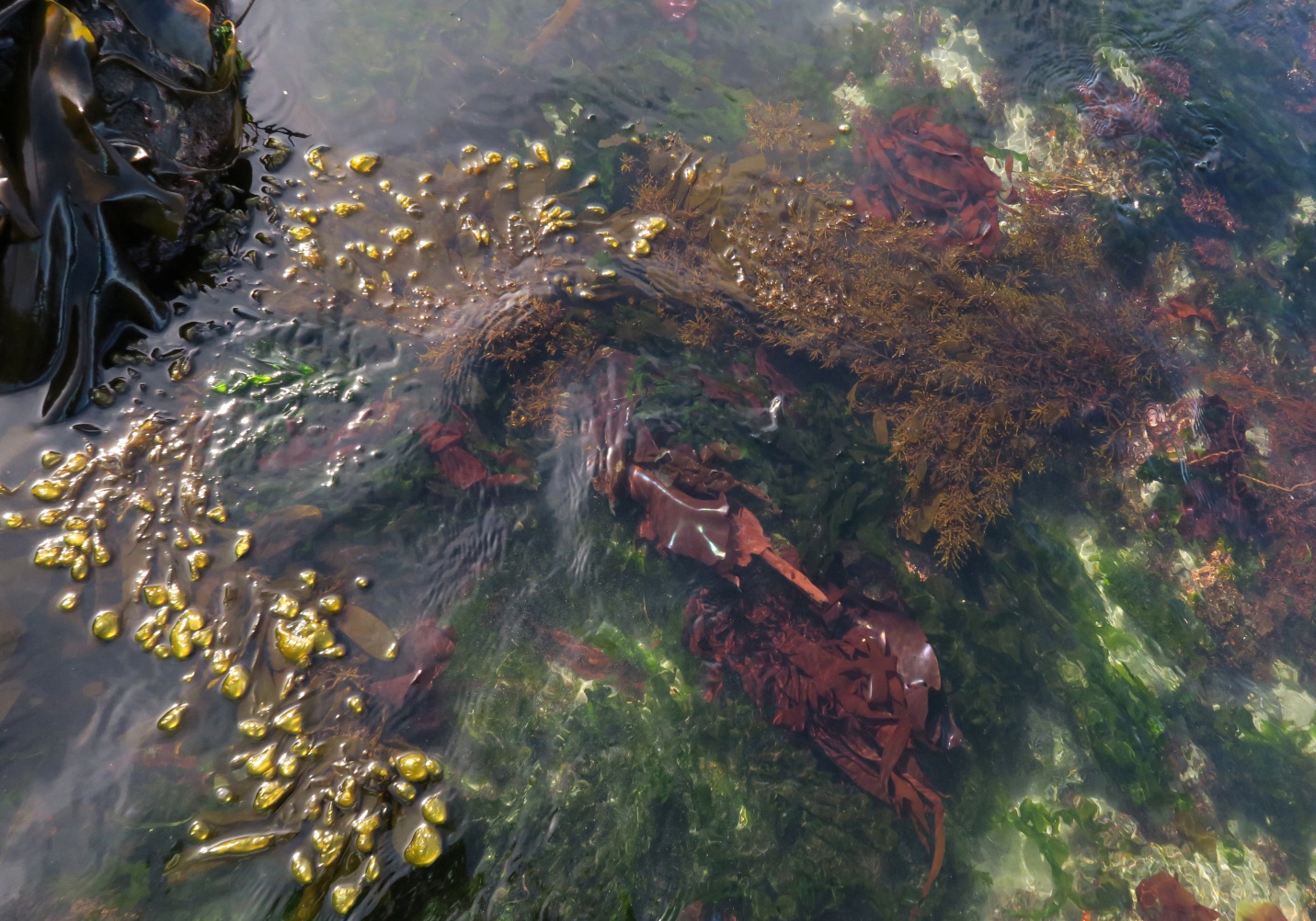
Figure 2: The floating and partially inflated greenish yellow Sea Chips algae caught our attention, and sure enough, where you find Sea Chip algae you will surely also find their host – Stephanocystis geminata. Here the multi-branched golden brown colored Northern Bladder Chain seaweed stands out from the nearby greens and reds that also inhabit the low intertidal zone; it is in prime condition and has grown to nearly 3.5 meters in length. French Beach, Juan de Fuca Strait, B.C., Canada. July 11, 2025. Photo ID 27786 ©Seaweedwhisperings.com
Person 2:
Today we have a very low tide that is occurring with the first new moon just past the summer solstice. Due to the combination of these conditions we find you, Stephanocystis geminata, as you choose the very low intertidal or shallow subtidal as your home, and you do not persist long past summer’s peak.
Your long main axes grow from large sized rock cobbles; it is apparent that you need an anchor place with considerable substance to it.
Splayed out here today and grounded temporarily above the tide line, you are not a particularly attractive sight – in fact your own form is highly obscured by the abundance of another epiphytic seaweed species that chooses you as its host, Sea Chip.
While you aren’t strikingly attractive you are sizeable, and you lie in the shallow water, or just out of it, like a collection of bulky olive brown colored scarves that are twisted or rolled over each other. Your long branches do not tangle but they definitely are gently twisted together in a fashion adds to the obfuscation of your actual form. Between the twisting of your many stems and the abundance of the Sea Chip epiphyte it is really nearly impossible to see you, Stephanocystis geminata. Do you like that? It feels like you don’t really care, you’re impassive about your looks, and certainly don’t waste any of your energy emoting about the effects of water action and other algae.
You have sparse and very simple “leaves” on your thalli low down near your perennial holdfast, but this growth pattern soon transitions into your more complicated expression of many, many branches with a few small ‘leaflets’ and sets of small floats (pneumatocysts) strung along the branches mid-sections. There is one or two (rarely three) of these more brightly colored floats strung in rows, and the tip of each of these countless tiny chains of floats is pointed. This gives you a rather fancifully trimmed look. This fanciful part seems to be rather at odds with your impassive nature, but it is present nonetheless.
I almost used the word carefree to describe the impassivity I experienced in this seaweed, but carefree implies a bit more rebelliousness or joy than was sensed here.
Considering this I think ‘fanciful’ feels too full of emotion as a descriptor, too; I think I should find a more impartial or neutral word. I think this is what goes on for Stephanocystis geminata all the time – a persistent neutrality and absence of drama that could be described as detachment.
I think it’s best to call the pattern of the branches ‘distinctive’; it is reliably present and clearly recognizable. And just as the pattern of growth is notable, the individual parts are on all the small side when considered singly. However the overall size attained by the thallus does not remain small at all – in fact this seaweed becomes quite substantial; the main axes of individuals found here today are between 2 and 3 meters long and will grow to up to 5 meters in a single season.
The main axes of this seaweed are simple, cylindrical cords; they grow to be rather long however they produce side branches rather sparsely. Despite this sparse spacing the growth on them “ads up”, too, as there quite simply are many of these side branches. The overall result is a bushy looking seaweed that looks full. A single stem on its own is anything but full looking, but single stems are NOT how this seaweed lives; it is comprised of many stems arising together from its perennial base.
And today every Stephanocystis thallus we can find is highly populated with the brown epiphytic alga Coilodesme californica, also commonly known as Sea Chip. This epiphyte has quite a different character from its host; it is a more delicate in that it is a somewhat shiny surfaced, collapsible sac that can look rather like deflated brown balloons. Some of them here today are easily 15 cm long and they are countless in number.
It seems as if Stephanocystis geminata has found peace as it coexists with the Sea Chip seaweed. Is there symbiosis here, or is it something else? Perhaps it is simple obliviousness. Yes, it feels like it is the latter. Stephanocystis is indifferent to the presence of Sea Chip, even oblivious to any impact this association may have on its life. Growing in such numbers Sea Chip adds greatly to the overall mass that the host seaweed’s structure must support; when I lifted one main stem of Stephanocystis I found its weight was strikingly heavy. In fact, when I was trying to lift one of these main axes to view the pneumatocysts better, the whole heavy ‘stem’ broke away from the basal part of the seaweed. I was surprised by this easy severing. I was being gentle and tried to put no additional force on the thallus, but it broke away readily, almost too readily it seemed.
This reminded me of what I’ve read about this seaweed in reference books; there is a perennial basal portion of the seaweed that supports the long and more intricate and many branched proliferations with their chains of small floats. This annually-growing, long, many branched part typically gets to such a size that when faced with violent wave action of strong storms it will break away, leaving only the basal portion to survive, overwinter, and grow again the following spring.
Something in this seaweed seems to get carried away, or carried off with an idea or even a passing whim. It doesn’t seem to heed physical laws that would keep it more firmly and safely present in this reality. This must be why the large anchor rock is needed; the annual growth of this seaweed itself seems to be almost irresponsibly moving ever out and away from its starting point, and if there was any thought given to remaining connected to their perennial roots it is long forgotten. It seems that there is no awareness of potentially becoming too carried away in their unboundedness. But indeed there are some practical earthly constraints; there is a point beyond which their growth will create life ending consequences. Stephanocystis seems to want only to expand without limit and since all of its branches are supported by numerous small floats, they can perhaps deceive themselves that this is actually possible.
They are “supported to float” – this is the kind of contradiction of terms that can occur when talking about seaweeds and it is thanks to their watery environment that this is possible. Support often implies structures like beams and foundation footings and ballast – the type of strong physical parts that withstand the various forces of gravity and weather and so forth; floating, on the other hand, implies being free of ties or somehow defying, slipping between or even escaping normal mortal physical laws.
Stephanocystis geminata loves to be afloat..., floating easily and effortlessly. It loves to do this simply to “be floating”; it doesn’t take advantage of its ‘release’ from gravity to do anything at all. No, it just loves to float – float, float, float…
And because it floats so well, Stephanocystis forms a type of marine canopy that seems to be ideal as a home for Coilodesme californica. It has been postulated by some phycologists that there is some kind of symbiosis between these two seaweeds. a mutual benefit of some kind. Noting the way that Stephanocystis can get ‘carried away’ in its outwardly extending and floating growth, it’s easy to see how this benefits Sea Chip by providing countless places from which it can grow, but it wasn’t readily apparent what benefit Stephanocystis derives from the countless Sea Chip epiphytes. If Sea Chip does anything to ‘benefit’ Stephanocystis geminata it may be that as they grow in size and mass themselves they hasten and almost guarantee the seasonal growth’s breakage away from its base. This forces Stephanocystis back to its beginnings, back to “its roots”, back from floating way out into the beyond, and encourages them to start life anew next year.
As I pondered this duo a bit further and found that, indeed, this is the benefit that Sea Chip offers – it is to assist Stephanocystis geminata in their desire to finally and totally untether themselves from this world, freeing them to float away towards the next.
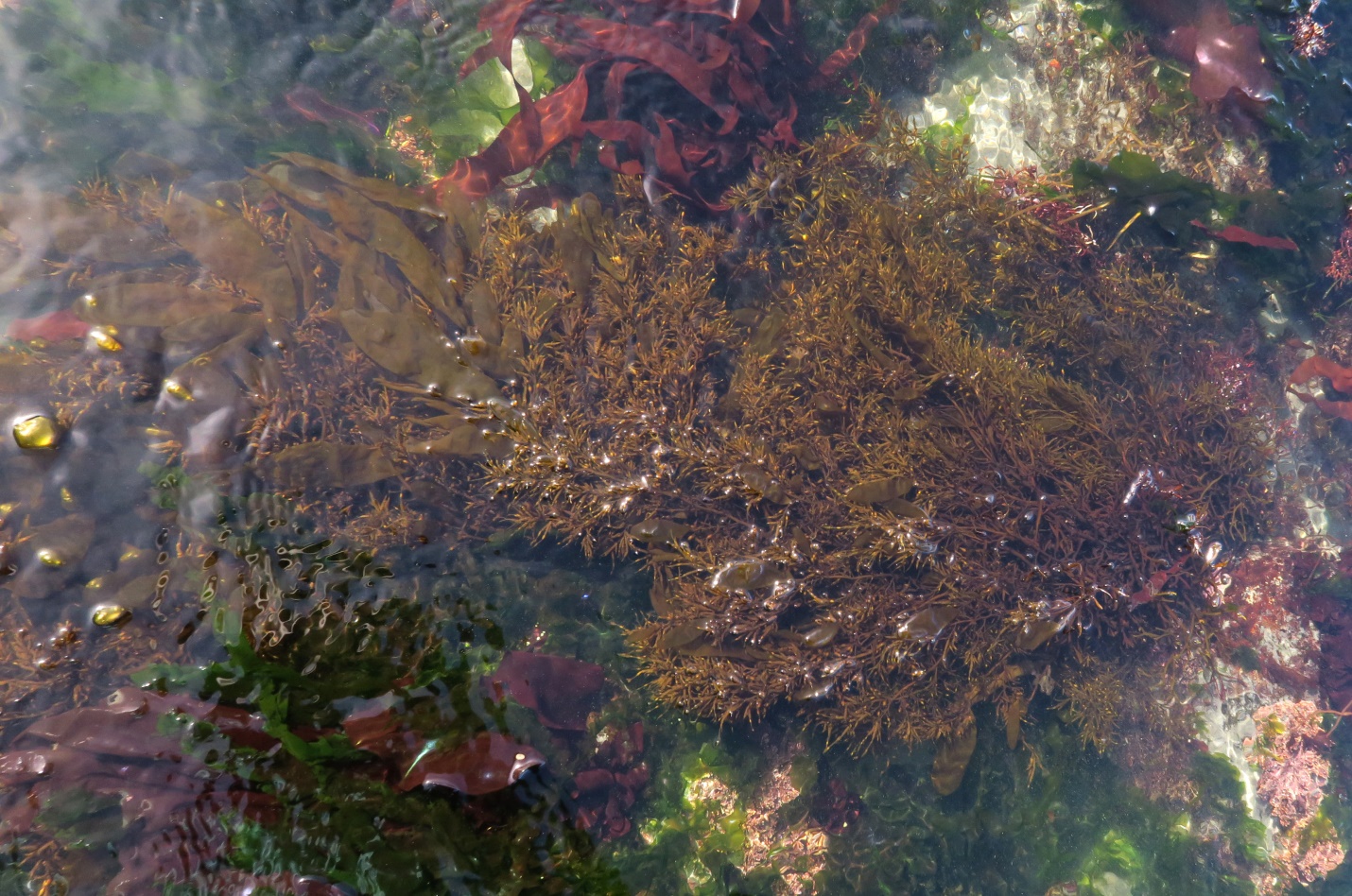
Figure 3: A closer look shows the first 1 to 1.5 meters of this Stephanocystis geminata seaweed. Its many stems and numerous branches with their tiny ‘floats’ are basking in the shallow water of low tide. Throughout S. geminata but especially to the left hand side you can see many flat balloon shaped Coilodesme californica (Sea Chip) algae. French Beach, Juan de Fuca Strait, B.C., Canada. July 11, 2025. Photo ID 27787 ©Seaweedwhisperings.com
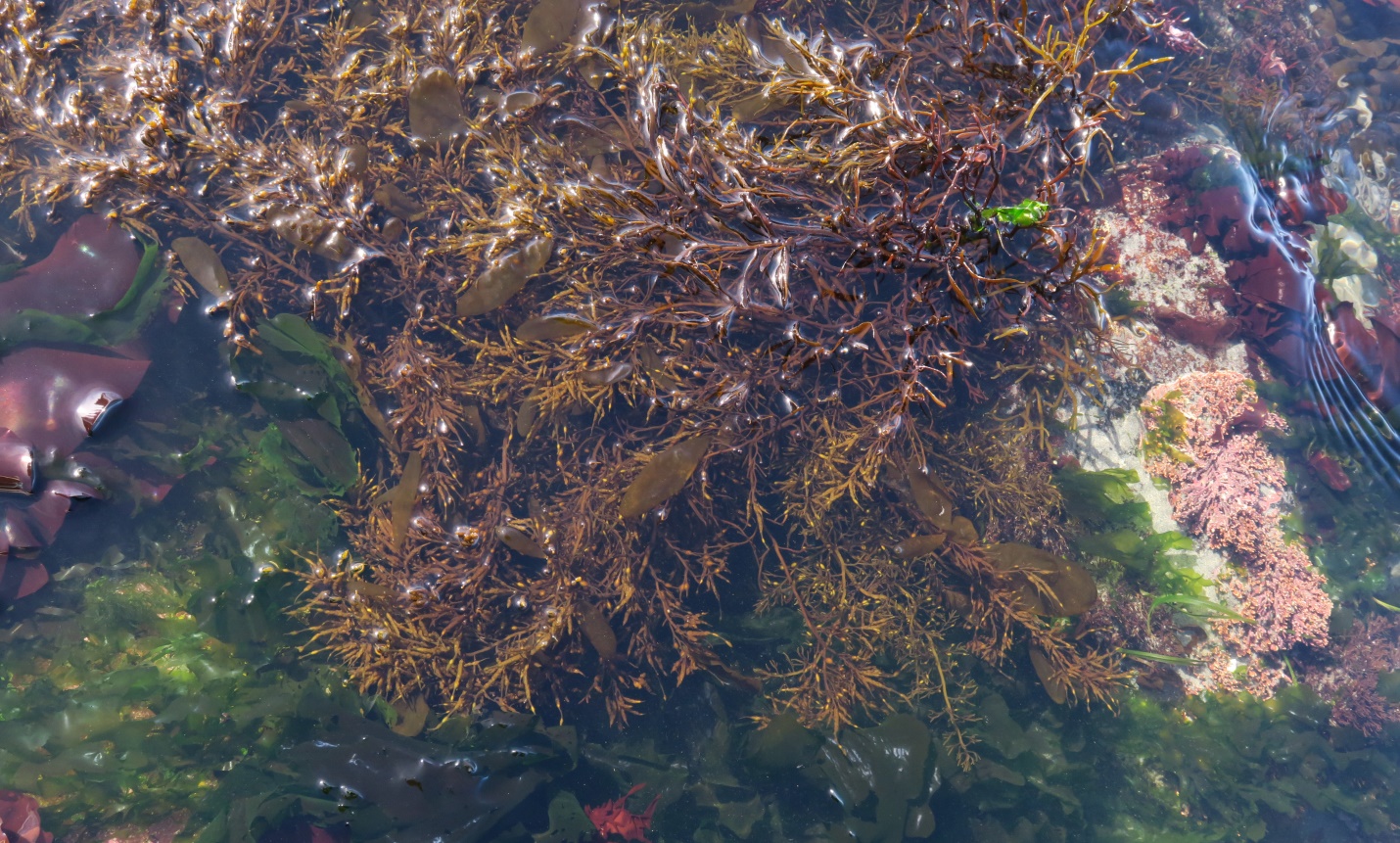
Figure 4: Closer still shows the perennial portion of this seaweed; it stands out with darker brown coloration and a few sparse ‘leaves’. It is anchored to the whitish looking boulder on the far right. Also depicted are numerous branchlets with their distinctive chains of floats and pointed tips, and not to be left out, there are a few smaller Sea Chip algae here also. French Beach, Juan de Fuca Strait, B.C., Canada. July 11, 2025. Photo ID 27788 ©Seaweedwhisperings.com
Discussion:
This seaweed is a master at getting really very ‘big’ by using many ‘little’ parts. They add up!
Numerous branches, with small golden round pneumatocysts and pointed tips – spread out in the water and seen against the contrasting Ulva-green backdrop, they are reminiscent of fireworks going off in the night sky. Bursts of light shooting out in different directions, fireworks are not long lived, but they are a showy, typically celebratory display. Is this seaweed like that in any way...?
Fireworks move upwards and outwards, away from the earth, then rather quickly, they fizzle and disappear. Their show is not long-lived but it is dramatic. The light and movement of fireworks is the result of an interaction of outside propelling forces – not something self-generated. Observing the movement of this seaweed as the low ocean swells rolled in was very lulling; the big fronds moved very gently in the water. They looked totally passive, totally given over to the water’s influence; this is not self-generated action, and like the fireworks, it is outward forces that propel its movement. All Stephanocystis has to do is be able to float! And the direction of the movement, out and away from earth and reaching into the atmosphere for the fireworks, and going on into the ether and moving ever out and away for the seaweed..., these are similar, too.
Is this seaweed’s life short? The annual growth certainly has its season AND it does seem to be cut short and ended rather dramatically. The first big storms of the late summer or fall will cause that easy severing we experienced, and the whole large, bulky mass of this alga, up to five meters of it, will completely break away, float out to sea to be consumed or decompose and die.
If there is celebration in this seaweed, it certainly is that of the “bliss of floating”. Bliss is not a word we use often, so we checked the definition. Bliss is “to reach a state of perfect happiness, typically so as to be oblivious of everything else”. Here obliviousness comes up once again with this seaweed – and ‘bliss’ is indeed the correct descriptor, although you won’t find that is directly expressed or communicated outwardly by Stephanocystis themselves; it is a state they simply seek to inhabit and a perceptive observer may intuit this as being the feeling behind their outward remoteness or detachment from this world.
We took the time to review photographs of this seaweed from our two very recent in-situ interactions and then proceeded with continued personal immersion. As Person 2 was writing observations, she noted that Person 1 was very still; when he took his chair and commenced his interaction he chose to close his eyes. Looking at him a few moments later Person 2 then wondered, has Person 1 fallen asleep? Indeed, he had fallen asleep! He was at one moment alert and present, albeit with his eyes closed, and then the next moment he was gone – he had floated away, gently drifting off into a calm and peaceful looking sleep.
He awoke when Person 2 shifted in her chair making a creaking sound that interrupted the previous stillness and silence. Person 1’s first comment was, “I don’t know what woke me”. It is interesting that he should wonder what woke him, rather than what had lulled him into sleep. This seems to indicate that sleep is the ‘normal’ state or the preferred state and being awake is not!
Falling asleep while sitting upright in a chair is highly unusual for him; in fact he later confirmed that he recalls never having done that before. It seems that there is a strong somnorific quality to the energy of this seaweed.
This is also highly unusual in terms of our seaweed interactions; neither of us has been lulled off to sleep while interacting with a seaweed before. We discussed what happened.
Person 2 noted that it was a warm summer afternoon, but that the room we were working in was cool and comfortable. We also considered our activities from the earlier part of the day. Person 2 asked Person 1, “Do you feel you were overdoing it today?” or “Did you get up too early this morning, perhaps?”
Person 1 replied, “No, none of that. I had a lack of interest in this seaweed. It just seemed there wasn’t much happening. I didn’t really want to spend much time with it in either of our interactions in the field. I was actually more interested in its partner the Coilodesme californica Sea Chip seaweed.”
Person 2: “So today dipping in again with this immersion, you lost interest and...?”
Person 1: “I lost interest and became inert.”
Person 2: “What do you mean by inert?”
Person 1: “Just not moving, just there.”
Person 2: “Just there and not moving, is this both your body and your mind?”
Person 1: “Yes. And it’s definitely different from being lazy; it’s not a lazy feeling. It’s a stopped, no movement feeling. In laziness there is often some action, with this there was the absence of action..., I was idle, inactive, lifeless, blank”.
Person 2: “How did that feel..., idle, inactive, lifeless, blank – was it unpleasant?”
Person 1: “No; it just was.”
It seems to us that this seaweed was sharing its way of being, and that the way to be is to not think, to not act, to not feel, to not do; it really seems to say give yourself over to the ocean and the forces around you and simply float.
It is completely NOT proactive; it IS totally passive, idle or blank.
There’s nothing to do physically; there is no mental puzzle to be solved; there are no emotions either.
The sparse growth pattern seen in the sizeable distance between branchlets, this may be a hint about this passivity. Stephanocystis geminata possibly only gives some energy to growing for a little while, like the short burst of a fireworks display, and then it falls back into its preferred state of inactivity.
We finished up. Person 2 said to Person 1, “Thanks for taking a nap!”
Person 1 replied, “Yes, I feel quite refreshed now. That doesn’t usually happen for me with a short nap.”
His “Stephanocystis nap” was only 5 or 10 minutes long; and sleep overcame him while seated upright in an ordinary chair. So the nap was not only extremely short, he was not exactly in a comfortable place or position to be napping either – this added to the surprise that the sleep was so refreshing.
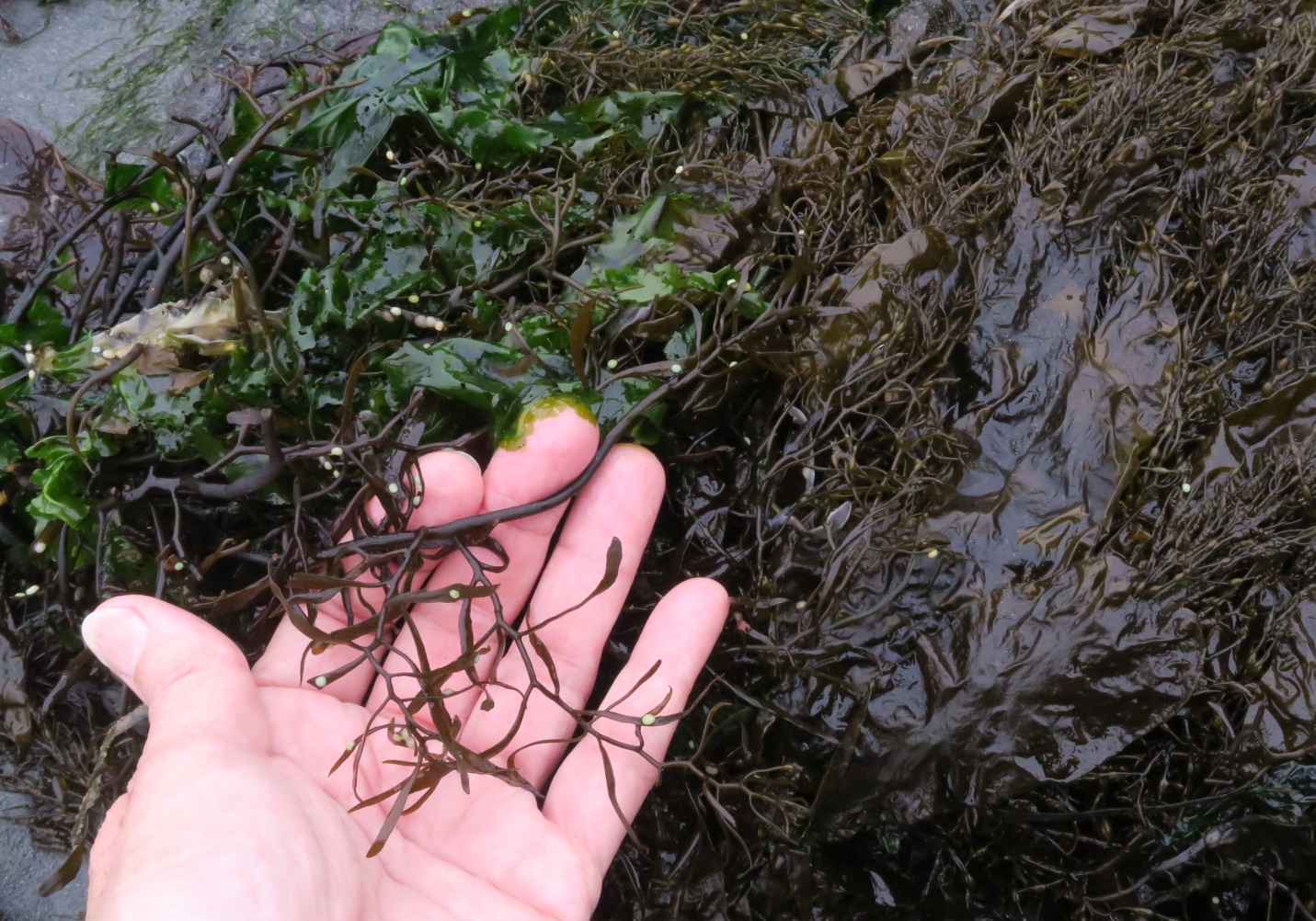
Figure 5: Viewed ‘in hand’ is a portion of the stem of this seaweed as it looks very close to its holdfast. This type of simple ‘leaf’ only grows here on the perennial portion of Stephanocystis geminata. The diameter of the cylindrical stem pictured is quite typical. Fishboat Bay, Juan de Fuca Strait, B.C., Canada. June 26, 2025. Photo ID 27789 ©Seaweedwhisperings.com
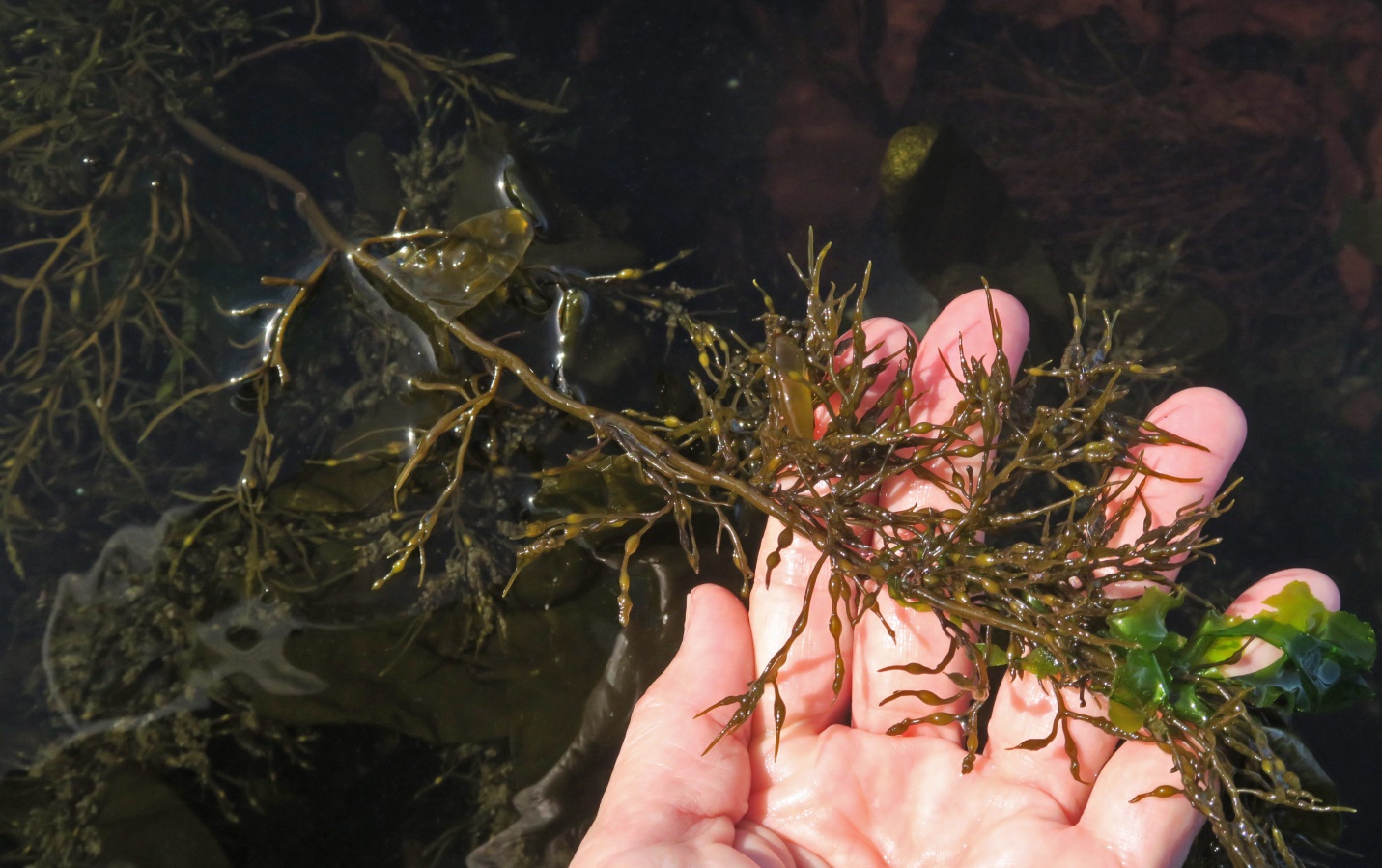
Figure 6: In hand here is the annual growth portion of this seaweed. Small branchlets with tiny pneumatocysts and pointed tips comprise the morphology of Northern Bladder Chain. French Beach, Juan de Fuca Strait, B.C., Canada. July 11, 2025. Photo ID 27790 ©Seaweedwhisperings.com
Biology & Natural History Information:
Description:
Overall color is medium to light brown with yellowish pneumatocysts. The thallus is anchored by a sturdy discoidal holdfast and the stiff stipe branches radially to give rise to several main branches, long secondary branches, and finally short terminal branchlets. The terminal branchlets carry small, oval, air-filled bladders (pneumatocysts) that can be single, paired, or in short chains terminating in a small pointed projection. The entire thallus can reach up to 5 meters high, even 8 meters in some instances, though usually it is much shorter. This species is canopy forming.
Habitat:
This perennial is found on rock in the low intertidal and upper subtidal zones of semi-exposed and sheltered habitats.
North Pacific Distribution:
Bering Sea and Aleutian Islands, Alaska, to northern Washington; Japan; Russia.
Remarks:
This seaweed is similar to Sargassum muticum, but the pointed tips on the pneumatocysts distinguish Stephanocystis (Sargassum’s bladders are occur strictly as singles). Other references note that the epiphytic brown alga Coilodesme californica only grows on Stephanocystis and not on Sargassum, so this is yet one more way to distinguish Stephanocystis from the similar invasive species, Sargassum muticum.
Classification:
Empire: Eukaryota
Kingdom: Chromista
Phylum: Heterokontophyta
Subphylum: Ochrophytina
Class: Phaeophysceae
Subclass: Fucophysidae
Order: Fucales
Family: Sargassaceae
Genus: Stephanocystis
Species: Stephanocystis geminata (C.Agardh) Draisma, Ballesteros, F.Rousseau & T.Thibaut 2010
Former name(s):
Cystoseria geminata C.Agardh 1824; Cystophyllum geminatum (C.Agardh) J. Agardh 1848; Cystoseira lepidum Ruprecht 1850.
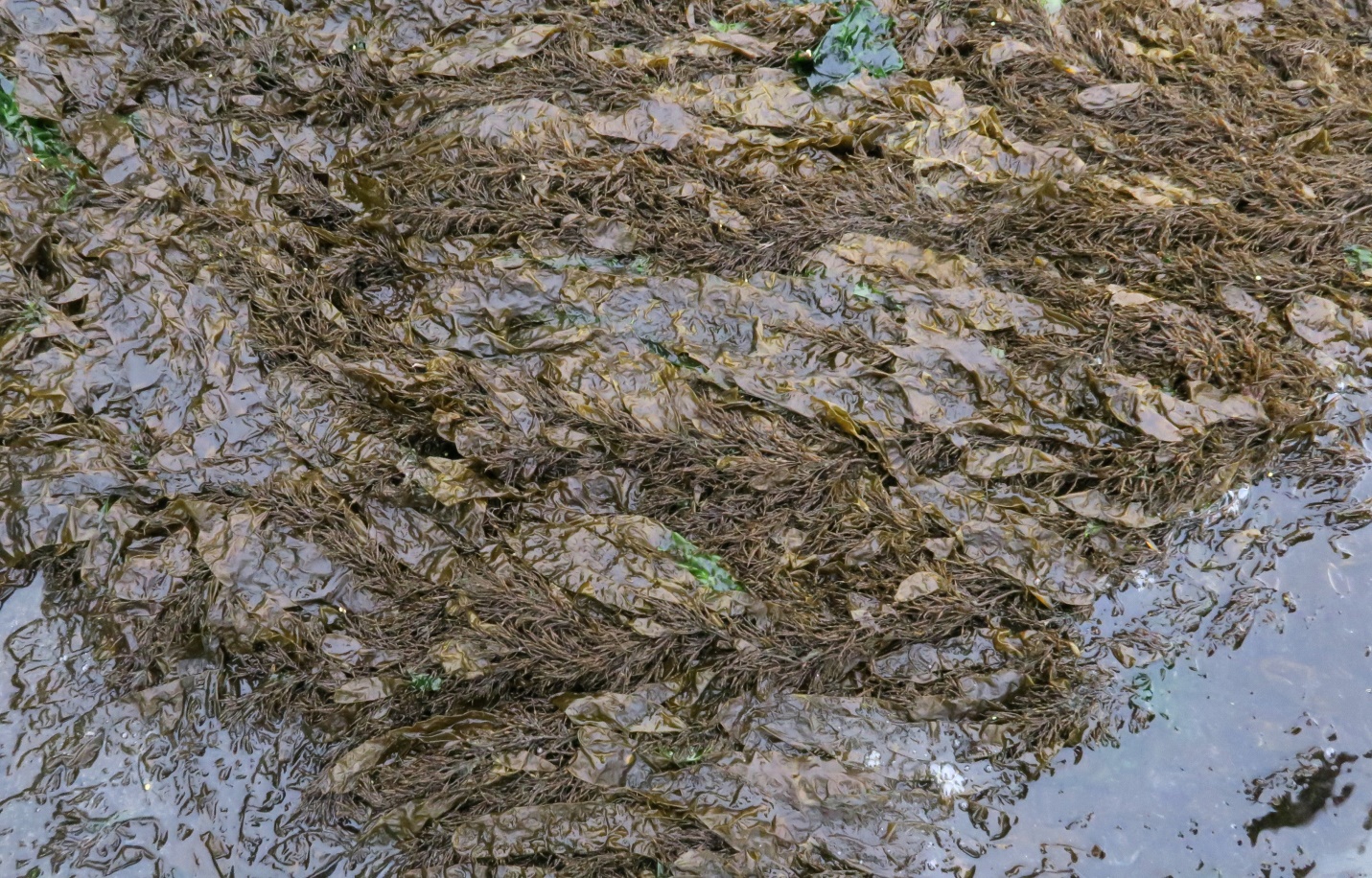
Figure 7: Grounded just above water, this large Stephanocystis geminata and Coilodesme californica combination has a striking look. The host alga is more intricate in design and its countless branches provide just the right habitat for the epiphyte, Sea Chip, to move in and grow with profusion. A significant symbiosis exists between the two brown alga species. Fishboat Bay, Juan de Fuca Strait, B.C., Canada. June 26, 2025. Photo ID 27791 ©Seaweedwhisperings.com
![]()